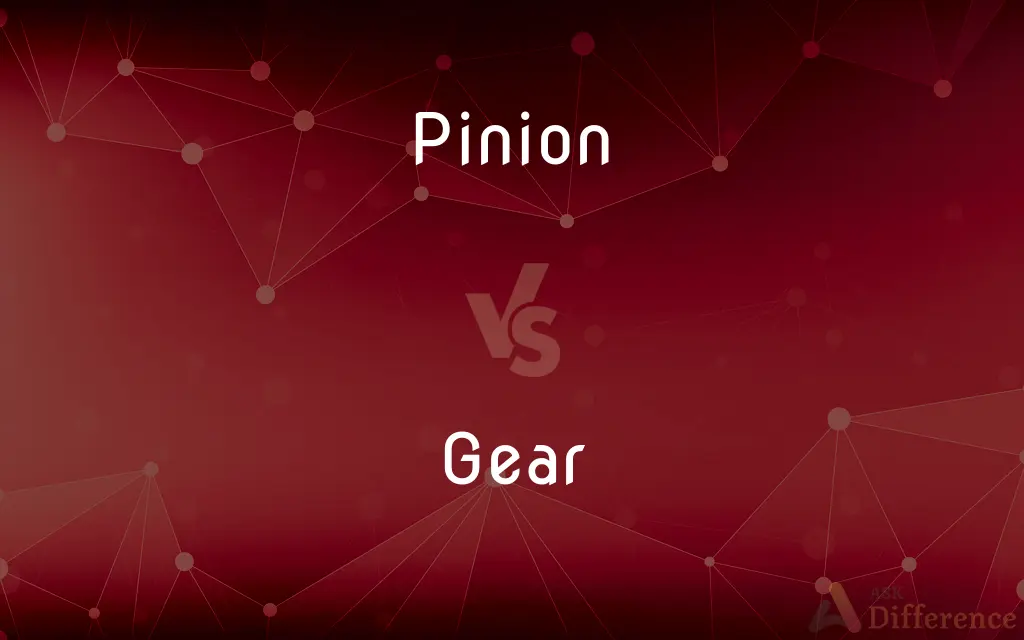Pinion vs. Gear — What's the Difference?
Edited by Tayyaba Rehman — By Maham Liaqat — Updated on March 29, 2024
A pinion is a small gear used in conjunction with a larger gear or rack, often to transmit motion or power, whereas a gear is a toothed wheel designed to transmit torque to another gear or toothed component in machinery.

Difference Between Pinion and Gear
Table of Contents
ADVERTISEMENT
Key Differences
Pinions are typically the smaller gears in gear systems and are crucial for altering the speed, torque, or direction of mechanical energy in machinery. They engage with larger gears or racks, allowing for precise control over the movement or power output. Gears, on the other hand, encompass a broader category of toothed wheels, including pinions, and are fundamental components in mechanical transmissions of all sizes and complexities. They can vary greatly in size, shape, and function, but all serve the primary purpose of transferring motion and force between components.
The interaction between a pinion and a larger gear often determines the mechanical advantage or the speed reduction ratio in a system. This means that while a pinion may drive or be driven by a larger gear, the specific arrangement and size difference significantly affect the output. Gears, while also engaging in similar interactions, are part of a larger system of transmission and can be used in various configurations to achieve the desired mechanical outcome.
Pinions, due to their smaller size, usually handle less load than their larger gear counterparts but are essential for initiating movement or making fine adjustments in mechanical systems. In contrast, gears can be designed to handle significant loads and are often part of larger assemblies where multiple gears work together to distribute or modify mechanical energy efficiently.
The design considerations for pinions include durability, precision, and compatibility with the gear or rack they engage with. For gears, considerations extend to material choice, tooth design, and the overall layout of the gear train, which must all be optimized for the specific application, whether for speed, torque, or direction change.
While pinions are a specialized type of gear focusing on the interaction with larger gears or racks for precise control, gears represent the broader category of toothed components involved in transmitting mechanical power. The use of pinions and gears is essential in various mechanical systems, from simple mechanical devices to complex machinery, highlighting their importance in modern engineering and design.
ADVERTISEMENT
Comparison Chart
Definition
A small toothed wheel that engages with a larger gear or rack.
A toothed wheel that engages with another toothed component to transmit torque.
Function
Primarily to transmit motion to or from a larger gear, altering speed or direction.
To transmit torque between gears, changing speed, direction, or torque.
Size
Generally smaller compared to the gear it engages with.
Can vary greatly in size, from very small to very large, depending on the application.
Load Handling
Handles less load due to smaller size and engagement with larger gears.
Can handle a wide range of loads, designed to fit specific mechanical requirements.
Design Consideration
Durability and precision for engaging with larger gears or racks.
Material, tooth design, and configuration for efficient power transmission.
Compare with Definitions
Pinion
A small gear that engages with a larger gear or rack.
The clock's mechanism relies on a pinion to drive the larger gear.
Gear
A toothed wheel designed for torque transmission.
Gears in the transmission box ensure the car moves smoothly.
Pinion
Designed for precise control in mechanical systems.
The steering pinion ensures smooth turning of the wheels.
Gear
Varies in size and function within systems.
The large gear works in harmony with smaller ones for precise operations.
Pinion
Handles less mechanical load.
The pinion's material was chosen for its durability despite the lower load.
Gear
Considered based on load, speed, and efficiency requirements.
Selecting the right gear material is crucial for the machinery's lifespan.
Pinion
Typically found in gear trains for speed or direction adjustment.
The motor's pinion is crucial for adjusting the conveyor belt's speed.
Gear
Can engage with other gears or toothed components.
The machine's efficiency is due to its well-designed gear system.
Pinion
Essential for initiating movement in systems.
The pinion engages first to start the mechanical process.
Gear
Key in distributing mechanical energy.
Each gear in the train contributes to the system's overall performance.
Pinion
A pinion is a round gear—usually the smaller of two meshed gears—used in several applications, including drivetrain and rack and pinion systems.
Gear
A gear is a rotating circular machine part having cut teeth or, in the case of a cogwheel or gearwheel, inserted teeth (called cogs), which mesh with another toothed part to transmit torque. A gear may also be known informally as a cog.
Pinion
The wing of a bird.
Gear
A toothed wheel that works with others to alter the relation between the speed of a driving mechanism (such as the engine of a vehicle) and the speed of the driven parts (the wheels)
A racing bike with ten-speed gears
Pinion
The outer rear edge of the wing of a bird, containing the primary flight feathers.
Gear
Equipment or apparatus that is used for a particular purpose
Camping gear
Pinion
A primary flight feather of a bird.
Gear
Design or adjust the gears in a machine to give a specified speed or power output
The vehicle's geared too high for serious off-road use
Pinion
A small cogwheel that engages or is engaged by a larger cogwheel or a rack.
Gear
A toothed machine part, such as a wheel or cylinder, that meshes with another toothed part to transmit motion or to change speed or direction.
Pinion
To remove or bind the wing feathers of (a bird) to prevent flight.
Gear
A complete assembly that performs a specific function in a larger machine.
Pinion
To cut or bind (the wings of a bird).
Gear
A transmission configuration for a specific ratio of engine to axle torque in a motor vehicle.
Pinion
To restrain or immobilize (a person) by binding the arms.
Gear
Equipment, such as tools or clothing, used for a particular activity
Fishing gear.
Pinion
To bind (a person's arms).
Gear
Clothing and accessories
The latest gear for teenagers.
Pinion
To bind fast or hold down; shackle.
Gear
Personal belongings, including clothing
Keeps her gear in a trunk.
Pinion
A wing.
Gear
The harness for a horse.
Pinion
(ornithology) The joint of a bird's wing farthest from the body.
Gear
A ship's rigging.
Pinion
(ornithology) Any of the outermost primary feathers on a bird's wing.
Gear
A sailor's personal effects.
Pinion
A moth of the genus ''Lithophane.
Gear
To equip with gears.
Pinion
(mechanical engineering) The smallest gear in a gear train.
Gear
To connect by gears.
Pinion
To cut off the pinion of a bird’s wing, or otherwise disable or bind its wings, in order to prevent it from flying.
Gear
To put into gear.
Pinion
To bind the arms of someone, so as to deprive him of their use; to disable by so binding.
Gear
To adjust or adapt so as to make suitable
Geared the speech to a conservative audience.
Pinion
To restrain; to limit.
Gear
To provide with gear; equip.
Pinion
A moth of the genus Lithophane, as Lithophane antennata, whose larva bores large holes in young peaches and apples.
Gear
To come into or be in gear.
Pinion
A feather; a quill.
Gear
To shift a transmission
Geared down to take the curve.
Pinion
A wing, literal or figurative.
Swift on his sooty pinions flits the gnome.
Gear
To become adjusted so as to fit or blend.
Pinion
The joint of bird's wing most remote from the body.
Gear
(uncountable) Equipment or paraphernalia, especially that used for an athletic endeavor.
Pinion
A fetter for the arm.
Gear
Clothing; garments.
Pinion
A cogwheel with a small number of teeth, or leaves, adapted to engage with a larger wheel, or rack (see Rack); esp., such a wheel having its leaves formed of the substance of the arbor or spindle which is its axis.
Gear
(obsolete) Goods; property; household items.
Pinion
To bind or confine the wings of; to confine by binding the wings.
Gear
(countable) A wheel with grooves (teeth) engraved on the outer circumference, such that two such devices can interlock and convey motion from one to the other; a gear wheel.
Pinion
To disable by cutting off the pinion joint.
Gear
A particular combination or choice of interlocking gears, such that a particular gear ratio is achieved.
Pinion
To disable or restrain, as a person, by binding the arms, esp. by binding the arms to the body.
Her elbows pinioned close upon her hips.
Gear
A configuration of the transmission of a motor car so as to achieve a particular ratio of engine to axle torque.
Pinion
Hence, generally, to confine; to bind; to tie up.
Gear
(aviation) landing gear
Gear-up landing
Get the gear down quick!
Pinion
A gear with a small number of teeth designed to mesh with a larger wheel or rack
Gear
Recreational drugs, including steroids.
Pinion
Any of the larger wing or tail feathers of a bird
Gear
Stuff.
Pinion
Wing of a bird
Gear
(obsolete) Business matters; affairs; concern.
Pinion
Bind the arms of
Gear
Anything worthless; nonsense; rubbish.
Pinion
Cut the wings off (of birds)
Gear
To provide with gearing; to fit with gears in order to achieve a desired gear ratio.
Gear
To be in, or come into, gear.
Gear
To dress; to put gear on; to harness.
Gear
(usually with to or toward(s)) To design or devise (something) so as to be suitable (for a particular type of person or a particular purpose).
This shop is not really geared towards people of our age.
They have geared the hotel mainly at tourists.
Gear
(finance) To borrow money in order to invest it in assets.
Gear
Great or fantastic
Gear
Clothing; garments; ornaments.
Array thyself in thy most gorgeous gear.
Gear
Goods; property; household stuff.
Homely gear and common ware.
Gear
Whatever is prepared for use or wear; manufactured stuff or material.
Clad in a vesture of unknown gear.
Gear
The harness of horses or cattle; trapping.
Gear
Warlike accouterments.
Gear
Manner; custom; behavior.
Gear
Business matters; affairs; concern.
Thus go they both together to their gear.
Gear
A toothed wheel, or cogwheel; as, a spur gear, or a bevel gear; also, toothed wheels, collectively.
Gear
See 1st Jeer (b).
Gear
Anything worthless; stuff; nonsense; rubbish.
That servant of his that confessed and uttered this gear was an honest man.
Gear
To dress; to put gear on; to harness.
Gear
To provide with gearing.
Gear
To adapt toward some specific purpose; as, they geared their advertising for maximum effect among teenagers.
Gear
To be in, or come into, gear.
Gear
A toothed wheel that engages another toothed mechanism in order to change the speed or direction of transmitted motion
Gear
A mechanism for transmitting motion by gears for some specific purpose (as the steering gear of a vehicle)
Gear
Equipment consisting of miscellaneous articles needed for a particular operation or sport etc.
Gear
Set the level or character of;
She pitched her speech to the teenagers in the audience
Common Curiosities
Can a gear system consist only of pinions?
No, a gear system requires at least one pinion and another gear or rack to function, as the pinion's role is to interact with these larger components.
What distinguishes a pinion from a gear?
A pinion is a specific type of gear, typically smaller and used to engage with larger gears or racks, focusing on precise control and adjustment of mechanical motion.
How is the load capacity of a gear determined?
The load capacity of a gear is determined by its material, size, and design, including the tooth profile and the system configuration it is part of.
Why are gears important in machinery?
Gears are crucial for transmitting torque between components, enabling machinery to function efficiently by altering speed, direction, or torque according to need.
What are common applications for pinions and gears?
Pinions and gears are used in various applications, from automotive transmissions and clocks to industrial machinery and electronic devices, due to their ability to precisely control and transmit mechanical power.
Can the design of a pinion influence the efficiency of a gear system?
Yes, the design of a pinion, including its tooth shape and size, significantly influences the overall efficiency and performance of a gear system.
What factors are considered in the design of gears and pinions?
Factors include material durability, tooth profile, size, and the specific operational requirements, such as speed, torque, and direction of transmission.
How do pinions and gears contribute to energy efficiency?
Pinions and gears contribute to energy efficiency by optimizing the transmission of mechanical power with minimal loss, effectively converting energy into useful work.
Is there a difference in maintenance requirements between pinions and gears?
Maintenance requirements can vary based on the specific application and material but generally involve regular inspection for wear, lubrication, and alignment checks to ensure optimal performance.
How does the size of a pinion affect its function?
The size of a pinion, being smaller, allows for finer control and adjustment in the transmission of mechanical power, especially in terms of speed and direction.
Share Your Discovery

Previous Comparison
Exercise vs. Problem
Next Comparison
Pylon vs. PilingAuthor Spotlight
Written by
Maham LiaqatEdited by
Tayyaba RehmanTayyaba Rehman is a distinguished writer, currently serving as a primary contributor to askdifference.com. As a researcher in semantics and etymology, Tayyaba's passion for the complexity of languages and their distinctions has found a perfect home on the platform. Tayyaba delves into the intricacies of language, distinguishing between commonly confused words and phrases, thereby providing clarity for readers worldwide.















































